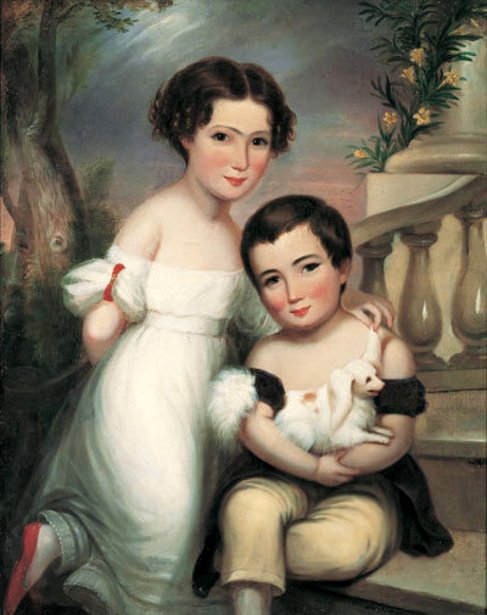GEORGE ESTEN COOKE
(St. Mary’s County, Maryland 1793 – 1849 New Orleans, Louisiana)
Portrait of a Boy with a Squirrel
Monogrammed, upper left: G.C.
Oil on canvas
10 ½ x 12 ¼ inches (26.7 x 31.1 cm)
Provenance:
Lewis J. Ruskin, Arizona, 1958–1981; thence by descent to the present owner.
This charming portrait of a young boy with his pet squirrel is a newly-discovered work by George Esten Cooke, an itinerant American painter who was active across the Antebellum South. Born on the eastern shore of Maryland, Cooke was essentially self-taught as an artist before establishing himself in Washington D.C., where he trained and later collaborated with Charles Bird King. Cooke led a peripatetic life in search of portrait commissions, with his main centers of activity being Washington D.C.; Richmond, VA; Montgomery, AL; Charleston, SC; Athens, GA; and New Orleans, LA. He also spent a significant period of study in Italy in the late 1820s. His career was the subject of a 1991 monographic exhibition organized by the Georgia Museum of Art.
The subject of this portrait is an elegantly dressed boy shown seated and in a relaxed pose with his legs crossed. While his identity is unknown, his clothing—particularly his blue coat with gold buttons and bright white pants—are indicators of his family’s status. The artist has added interest and emphasized the subject’s youth through the depiction of his windswept hair and the loosely painted brimmed hat leaning casually against his leg. Cooke’s hand is here apparent in the child’s large eyes and simpering smile, as well the pink sky of the landscape—all characteristic of the artist’s style.
Our portrait is prominently signed with the monogram “G.C.” seemingly carved into the bark of the tree at left. The motif of the tree with small circular wood wounds was one to which Cooke returned on several occasions, both as a compositional device and a prominent location for his signature (Figs. 1-2). Less common in his works is the inclusion of a sitter’s pet—here a wonderfully observed squirrel munching on an acorn while perched on the boy’s arm.
Although undated, our painting is closest in style to Cooke’s child portraits of the 1840s, when he was working throughout Georgia and Alabama, as well as in New Orleans. Cooke wrote at this time that “numerous small paintings fill up my odd moments, so that no time runs to waste”—and the intimate scale of this painting suggests that our work is one such example from the period.[i] The work finds its closest cognate both in style and execution in Cooke’s depiction of Joseph Fairfax Lapsley (Fig. 3).
Cooke spent a significant period in New Orleans—first in 1842, residing at 36 Marigny Street, and again in 1844, beginning one of the most important chapters of his career. There he met Daniel Pratt, the Alabama industrialist, who became one of his most significant patrons and supporters. Cooke rented two floors of Pratt’s warehouse at 13 St. Charles Street in New Orleans, which the artist opened as a studio and gallery. He advertised this space as the National Gallery of Painting, and he organized exhibitions there with works of many of the prominent American artists of the day—including Thomas Cole, Thomas Doughty, John Gadsby Chapman, Thomas Sully, Emanuel Leutze, and Daniel Huntington—as well as his own. Cooke died in New Orleans in 1849 after several years of operating the gallery and continuing his work as an itinerant painter. Despite his wishes to be buried in New Orleans, he was interred at Prattville, AL, near the home and private gallery of Daniel Pratt—the major repository of his work.
Fig. 1. George Cooke, Portrait of Western Berkeley Thomas and Emily Howard Thomas, 1840, oil on canvas, 36 x 28 ½ inches, Morris Museum of Art, Augusta, Georgia.
Fig. 2. George Cooke, Portrait of a Woman Sketching, oil on canvas, formerly Private Collection, UK.
Fig. 3. George Cooke, Portrait of Joseph Fairfax Lapsley, oil on canvas, 56 x 48 inches, The Johnson Collection, Spartanburg, SC.
[i] Linda Crocker Simmons, “Chronological Survey,” in George Cooke: 1793–1849, exh. cat., Athens, GA, 1991, p. 18, footnote 46.




